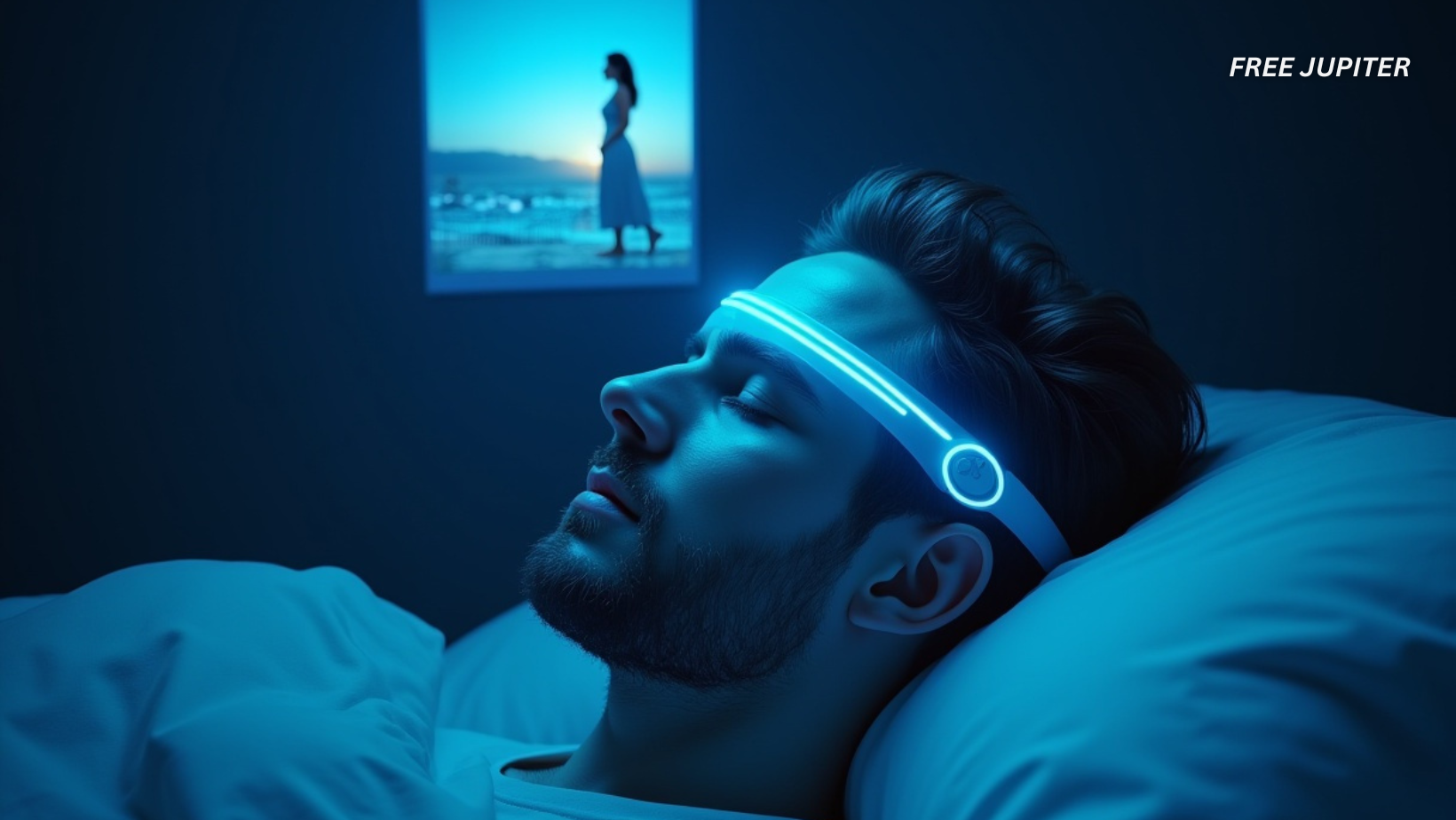Friendly Note: FreeJupiter.com shares general info for curious minds 🌟 Please fact-check all claims—and always check health matters with a professional 💙
What if you could wake up and watch your dream like a movie? No more struggling to remember fuzzy images or strange storylines—just hit play and revisit your night’s adventures. It might sound like a plot twist in a sci-fi film, but a group of scientists in Japan is making it a real possibility.
They’ve built a headset that can record parts of your dreams and replay them when you wake up. And while it’s not perfect (yet), the science behind it is surprisingly real—and really cool.
Turning Brainwaves Into Dream Scenes
The device was developed by researchers at ATR Computational Neuroscience Laboratories in Kyoto, led by Professor Yukiyasu Kamitani. To pull this off, they used a type of brain scanner called fMRI (short for functional magnetic resonance imaging). This machine watches which parts of your brain are active and when, like a high-tech brain heat map.
Here’s what the researchers did: they asked volunteers to sleep while hooked up to the scanner. When the participants drifted into REM sleep—the stage where dreams usually happen—the researchers would gently wake them and ask what they saw. Over time, they built a detailed “dictionary” that linked certain brain patterns to specific images and themes from people’s dreams.
This data was then handed over to artificial intelligence (AI), which had been trained to recognize visual content—like people, animals, or objects—based on brain activity. By comparing dream-related brain signals to those patterns, the AI could reconstruct rough images of what the dreamer had just experienced.
And the results? The dream predictions were about 60% accurate overall, and for certain types of visuals—like clearly defined shapes or familiar objects—that accuracy jumped to over 70%.
What We’re Really Seeing When We “Watch” a Dream
Let’s clear something up: we’re not talking about HD dream videos just yet. What you see isn’t a crystal-clear playback of your dream, but rather a blurry, AI-generated visual that matches what your brain might have seen during the dream. Still, that’s a huge leap from having no record at all.
According to Professor Kamitani, these early experiments showed that their AI could guess dream content in a way that matched people’s own descriptions when they woke up. That’s a strong sign the system is decoding something meaningful.
Why This Tech Matters (It’s Not Just for Fun)
Sure, the idea of binge-watching your own dreams is fun. But the implications go way deeper.
This technology could open new doors in mental health care. By better understanding how dreams reflect our thoughts and emotions, psychologists may one day use dream analysis to help diagnose mental health conditions more accurately. For instance, recurring dreams or certain patterns in brain activity might give clues about anxiety, trauma, or other disorders.
Dr. Mark Stokes, a cognitive neuroscientist from the University of Oxford, called the project a major step toward building machines that can truly understand how we think—even when we’re asleep. That’s a big deal for science.
Still in Its Dreamy Beginnings
It’s important to remember this headset is still a work in progress. The dream images are far from perfect, and there’s much more to learn about how the brain constructs those wild nighttime stories. Emotions, symbolism, and deeper meaning are still out of reach for now.
But as AI and brain-scanning technology continue to improve, the future looks promising. Researchers are optimistic that we’ll one day be able to peek even deeper into the subconscious—to understand not just what we dream, but why.
Until then, the idea that we might someday replay a dream like a YouTube video is one small step for science, and one giant leap for our sleepy imaginations.
AI Recreates What You See—Straight From Your Brainwaves
From Sight to Signal: How AI Decoded Vision
Before diving into dreams, scientists tackled a simpler but equally astonishing challenge: Could machines learn to “see” what a person is looking at—just by analyzing brain activity? In 2023, researchers from Osaka University and Japan’s National Institute of Information and Communications Technology (NICT) answered with a confident yes.
In their experiment, participants viewed images—such as faces, animals, and natural scenes—while their brains were scanned using fMRI. As each image triggered a unique neural signature, the AI gradually learned to match those signals with the visual content being shown. Over time, it became good enough to generate reconstructed images that closely resembled what the person was viewing.
Read more: Immortality Is Closer Than You Think—Just 5 Years Away, Says Scientist
Mind to Monitor: Reconstructing Images Without a Camera
This wasn’t just guesswork—the recreated images were surprisingly close to the originals. While they weren’t crystal clear, they captured key features like shape, layout, and sometimes even color. The fact that an algorithm could piece together recognizable visuals purely from brainwave data was a breakthrough in itself.
It marked a major step toward decoding internal thought processes and showing that the brain’s visual language could be translated into pixels—without ever needing a screen or a lens.
Connecting the Dots: From Waking Thoughts to Sleeping Dreams
Though this project didn’t involve sleep, it helped pave the road for dream decoding. If AI could reconstruct real-time perception, why not try to map out the images our brain conjures during sleep?
That’s exactly the leap Professor Yukiyasu Kamitani’s team made with their dream-recording research. They used similar AI training methods—only this time, the visual data came from dreams instead of real-world images. The result? Blurry but believable dream visuals, built entirely from sleeping brain patterns.
The Foundation for Future Brain-Tech
The ability to decode thoughts, dreams, and mental images isn’t just a sci-fi gimmick—it could be a turning point for how we understand the human brain and treat its disorders.
Revolutionizing Mental Health and Therapy
One of the biggest potential impacts of this technology lies in mental health. Imagine being able to see the dreams of someone struggling with trauma, anxiety, or depression. Therapists could use dream recordings and neural visualizations to uncover hidden patterns, recurring symbols, or unspoken fears—things that patients may not even be aware of, let alone able to describe. It could give therapists a clearer window into the subconscious, offering insights into emotional health that talk therapy or questionnaires alone can’t provide.
For those with conditions like PTSD, whose traumatic experiences often resurface in vivid nightmares, this tech could eventually help track how treatments are working—or even guide new interventions designed to change the way painful memories play out during sleep.
Read more: There’s Something in Your Poop That May Predict Imminent Death
A Voice for the Voiceless
Brain-reading tools also hold enormous promise for people who can’t communicate in traditional ways—such as individuals with locked-in syndrome, severe strokes, or late-stage ALS. If machines can learn to decode dreams and visuals from brain activity, then eventually, they may also be able to interpret imagined speech or thoughts.
In other words, this research could someday give a voice to those who have none, by translating neural activity directly into language or images.
The Future of Human-Computer Interfaces
This dream-recording headset is part of a much larger movement toward building direct interfaces between the human brain and computers. Think of it as the groundwork for technologies like mind-controlled devices, virtual reality driven by thought, and even the ability to share memories or experiences in real time—just by thinking them.
Companies like Neuralink and OpenBCI are already exploring this frontier. Dream decoding may seem niche right now, but it’s part of the same roadmap: using AI and neuroscience to break the boundaries between mind and machine.
In short, the invention of dream-recording devices and brain-decoding AI isn’t just about watching the movie of your dreams—it’s about rewriting the way we interact with our own minds, and possibly with each other. We’re standing at the edge of a new era where inner experiences might no longer be locked inside our heads.










